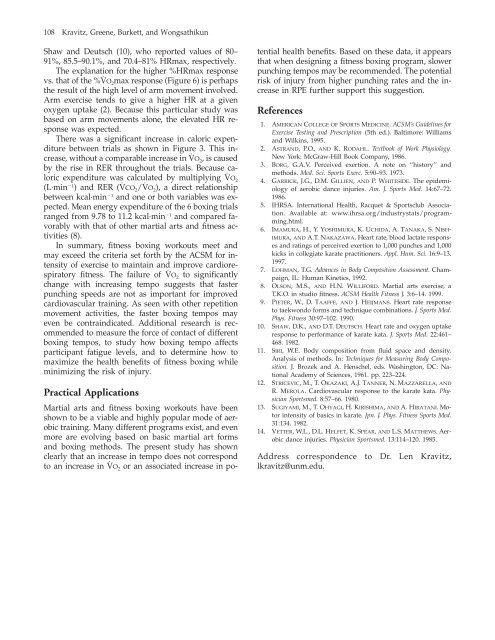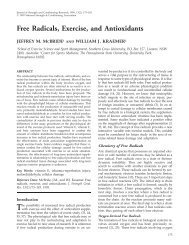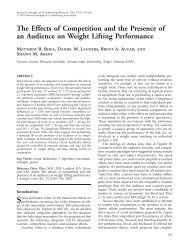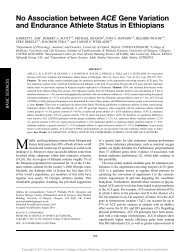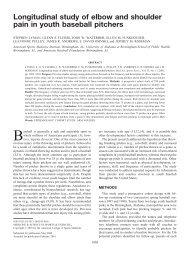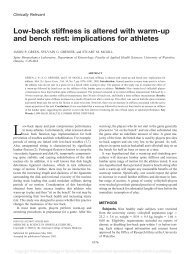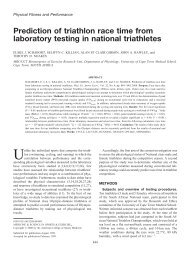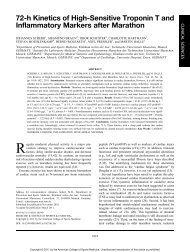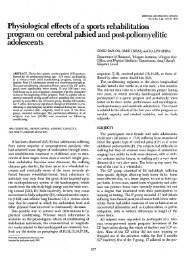Cardiovascular Response to Punching Tempo - Setanta College
Cardiovascular Response to Punching Tempo - Setanta College
Cardiovascular Response to Punching Tempo - Setanta College
You also want an ePaper? Increase the reach of your titles
YUMPU automatically turns print PDFs into web optimized ePapers that Google loves.
108 Kravitz, Greene, Burkett, and Wongsathikun<br />
Shaw and Deutsch (10), who reported values of 80–<br />
91%, 85.5–90.1%, and 70.4–81% HRmax, respectively.<br />
The explanation for the higher %HRmax response<br />
vs. that of the %V˙ O2max response (Figure 6) is perhaps<br />
the result of the high level of arm movement involved.<br />
Arm exercise tends <strong>to</strong> give a higher HR at a given<br />
oxygen uptake (2). Because this particular study was<br />
based on arm movements alone, the elevated HR response<br />
was expected.<br />
There was a significant increase in caloric expenditure<br />
between trials as shown in Figure 3. This increase,<br />
without a comparable increase in V˙ O2, is caused<br />
by the rise in RER throughout the trials. Because caloric<br />
expenditure was calculated by multiplying V˙ O2<br />
(L·min �1 ) and RER (V˙ CO2/V˙ O2), a direct relationship<br />
between kcal·min �1 and one or both variables was expected.<br />
Mean energy expenditure of the 6 boxing trials<br />
ranged from 9.78 <strong>to</strong> 11.2 kcal·min �1 and compared favorably<br />
with that of other martial arts and fitness activities<br />
(8).<br />
In summary, fitness boxing workouts meet and<br />
may exceed the criteria set forth by the ACSM for intensity<br />
of exercise <strong>to</strong> maintain and improve cardiorespira<strong>to</strong>ry<br />
fitness. The failure of V˙ O2 <strong>to</strong> significantly<br />
change with increasing tempo suggests that faster<br />
punching speeds are not as important for improved<br />
cardiovascular training. As seen with other repetition<br />
movement activities, the faster boxing tempos may<br />
even be contraindicated. Additional research is recommended<br />
<strong>to</strong> measure the force of contact of different<br />
boxing tempos, <strong>to</strong> study how boxing tempo affects<br />
participant fatigue levels, and <strong>to</strong> determine how <strong>to</strong><br />
maximize the health benefits of fitness boxing while<br />
minimizing the risk of injury.<br />
Practical Applications<br />
Martial arts and fitness boxing workouts have been<br />
shown <strong>to</strong> be a viable and highly popular mode of aerobic<br />
training. Many different programs exist, and even<br />
more are evolving based on basic martial art forms<br />
and boxing methods. The present study has shown<br />
clearly that an increase in tempo does not correspond<br />
<strong>to</strong> an increase in V˙ O2 or an associated increase in po-<br />
tential health benefits. Based on these data, it appears<br />
that when designing a fitness boxing program, slower<br />
punching tempos may be recommended. The potential<br />
risk of injury from higher punching rates and the increase<br />
in RPE further support this suggestion.<br />
References<br />
1. AMERICAN COLLEGE OF SPORTS MEDICINE. ACSM’s Guidelines for<br />
Exercise Testing and Prescription (5th ed.). Baltimore: Williams<br />
and Wilkins, 1995.<br />
2. ASTRAND, P.O., AND K. RODAHL. Textbook of Work Physiology.<br />
New York: McGraw-Hill Book Company, 1986.<br />
3. BORG, G.A.V. Perceived exertion. A note on ‘‘his<strong>to</strong>ry’’ and<br />
methods. Med. Sci. Sports Exerc. 5:90–93. 1973.<br />
4. GARRICK, J.G., D.M. GILLIEN, AND P. WHITESIDE. The epidemiology<br />
of aerobic dance injuries. Am. J. Sports Med. 14:67–72.<br />
1986.<br />
5. IHRSA. International Health, Racquet & Sportsclub Association.<br />
Available at: www.ihrsa.org/industrystats/programming.html.<br />
6. IMAMURA, H.,Y.YOSHIMURA, K.UCHIDA, A.TANAKA, S.NISH-<br />
IMURA, AND A.T. NAKAZAWA. Heart rate, blood lactate responses<br />
and ratings of perceived exertion <strong>to</strong> 1,000 punches and 1,000<br />
kicks in collegiate karate practitioners. Appl. Hum. Sci. 16:9–13.<br />
1997.<br />
7. LOHMAN, T.G. Advances in Body Composition Assessment. Champaign,<br />
IL: Human Kinetics, 1992.<br />
8. OLSON, M.S., AND H.N. WILLIFORD. Martial arts exercise, a<br />
T.K.O. in studio fitness. ACSM Health Fitness J. 3:6–14. 1999.<br />
9. PIETER, W.,D.TAAFFE, AND J. HEIJMANS. Heart rate response<br />
<strong>to</strong> taekwondo forms and technique combinations. J. Sports Med.<br />
Phys. Fitness 30:97–102. 1990.<br />
10. SHAW, D.K., AND D.T. DEUTSCH. Heart rate and oxygen uptake<br />
response <strong>to</strong> performance of karate kata. J. Sports Med. 22:461–<br />
468. 1982.<br />
11. SIRI, W.E. Body composition from fluid space and density.<br />
Analysis of methods. In: Techniques for Measuring Body Composition.<br />
J. Brozek and A. Henschel, eds. Washing<strong>to</strong>n, DC: National<br />
Academy of Sciences, 1961. pp. 223–224.<br />
12. STRICEVIC, M.,T.OKAZAKI, A.J. TANNER, N.MAZZARELLA, AND<br />
R. MEROLA. <strong>Cardiovascular</strong> response <strong>to</strong> the karate kata. Physician<br />
Sportsmed. 8:57–66. 1980.<br />
13. SUGIYAMI, M.,T.OHYAGI, H.KIRISHIMA, AND A. HIRATANI.Mo<strong>to</strong>r<br />
intensity of basics in karate. Jpn. J. Phys. Fitness Sports Med.<br />
31:134. 1982.<br />
14. VETTER, W.L., D.L. HELFET, K.SPEAR, AND L.S. MATTHEWS.Aerobic<br />
dance injuries. Physician Sportsmed. 13:114–120. 1985.<br />
Address correspondence <strong>to</strong> Dr. Len Kravitz,<br />
lkravitz@unm.edu.


